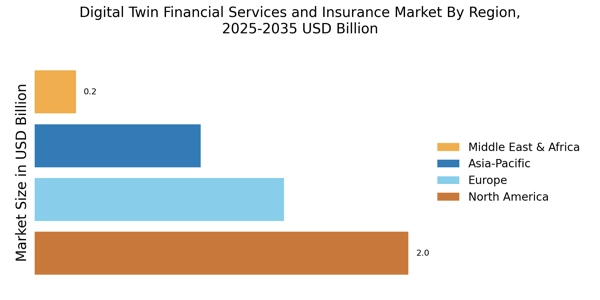Demand for Real-Time Data Analytics
The growing demand for real-time data analytics is a significant driver of the Digital Twin Financial Services and Insurance Market. Financial institutions are increasingly recognizing the value of real-time insights for enhancing customer experiences and optimizing operations. Digital twins provide a dynamic platform for analyzing data as it flows, allowing companies to make informed decisions quickly. This capability is particularly crucial in the insurance sector, where timely data can influence underwriting and claims processing. Market Research Future indicates that organizations utilizing real-time analytics can achieve up to a 25% reduction in operational costs, further underscoring the importance of digital twin technologies in this context.
Integration of Advanced Technologies
The integration of advanced technologies such as artificial intelligence, machine learning, and the Internet of Things is driving the Digital Twin Financial Services and Insurance Market. These technologies enable the creation of highly accurate digital twins that simulate real-world scenarios, allowing financial institutions to analyze vast amounts of data in real time. This capability enhances decision-making processes and risk assessment, leading to improved customer satisfaction and operational efficiency. According to recent estimates, the adoption of these technologies could lead to a 30% increase in operational efficiency within the sector. As financial services and insurance companies increasingly leverage these innovations, the demand for digital twin solutions is expected to rise significantly.
Regulatory Compliance and Risk Mitigation
Regulatory compliance remains a critical driver in the Digital Twin Financial Services and Insurance Market. Financial institutions are under constant pressure to adhere to stringent regulations, which necessitates the implementation of robust risk management frameworks. Digital twins facilitate this by providing a comprehensive view of potential risks and compliance issues, enabling organizations to proactively address them. The market for compliance solutions is projected to grow at a compound annual growth rate of 12% over the next five years, indicating a strong demand for tools that can streamline compliance processes. As regulatory landscapes evolve, the role of digital twins in ensuring compliance and mitigating risks is likely to become increasingly vital.
Increased Focus on Customer-Centric Solutions
The shift towards customer-centric solutions is reshaping the Digital Twin Financial Services and Insurance Market. As consumers demand more personalized services, financial institutions are leveraging digital twins to create tailored offerings that meet individual needs. By simulating customer interactions and preferences, companies can design products that resonate with their target audience. This trend is reflected in the growing investment in customer experience technologies, which is expected to reach $10 billion by 2026. The ability to deliver personalized experiences not only enhances customer satisfaction but also fosters loyalty, making digital twins an essential tool for organizations aiming to thrive in a competitive landscape.
Sustainability and Environmental Considerations
Sustainability is becoming an increasingly important driver in the Digital Twin Financial Services and Insurance Market. Financial institutions are under pressure to adopt environmentally friendly practices and demonstrate corporate social responsibility. Digital twins can play a pivotal role in this transition by enabling organizations to model and assess the environmental impact of their operations. By simulating various scenarios, companies can identify opportunities for reducing their carbon footprint and improving resource efficiency. The market for sustainable finance solutions is projected to grow significantly, with estimates suggesting a potential increase of 20% annually. As sustainability becomes a core focus, the relevance of digital twins in supporting these initiatives is likely to expand.


















Leave a Comment